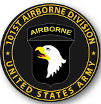

Operation APACHE SNOW a multi-regiment operation centered 43km south-southwest of Quang Tri in Quang Tri and Thua Thien Province, commenced on 10 May with two battalions of the 9th MAR REGT conducting interdiction operations in the southern Da Krong Valley; four battalions of the 3d BDE, 101st ABN (AM) with supporting elements and four battalions of the 1st ARVN INF DIV combining to conduct combat assaults into the northern A Shau Valley to destroy enemy caches, forces, and installations, and prevent exfiltration into Laos.
The operation began with a heliborne assault into the thickly jungled mountains along the Laotian boarder west of the valley. The US forces also established a FSB at Ta Bat, an abandoned village in the valley's center. By placing themselves between the valley and the Laotian border, Allied forces attempted to trap Communist forces in the valley and cut them off from reinforcements waiting beyond the border. There was little contact the first day as the airborne troopers began sweeping eastward toward the valley.
On 12 May, however, the 3d BN, 187th ABN INF ran into heavy RPG and automatic weapons fire from the enemy in deep bunkers on Hill 937 (Ap Bia Mountain). The bunkers were well designed with interlocking fields of fire and scarcely visible silhouettes. The troopers held back, calling in artillery and TACAIR on the enemy positions. On 13 May, two companies attacked the northwest ridges of the hill. Encountering intense fire, they were ordered to fall back. Artillery and TACAIR again pounded the ridgeline with high explosives and napalm during the night and early morning. On 14 May, the full battalion was sent against the enemy's position; however, the commander of the lead company was wounded, and the company's radio was silenced. Again, a withdrawal was ordered and supporting fires called for. The 3d BN, 187th ABN INF was reinforced by three other battalions, two from the 101st ABN DIV (AM) and one from the 1st ARVN INF DIV, which were positioned to surround Hill 937.
On 18 May, after 36 additional hours of artillery and TACAIR strikes, two of the battalions attacked again, the 3d BN, 187th ABN INF moving southeast and the 1st BN, 506th ABN INF moving north. By mid-afternoon some of the platoons had reached the summit but a thunderstorm drenched the hill, visibility dropped to zero, and soldiers were unable to keep their footing in the mud. A fourth withdrawal was ordered. Finally, on 20 May after heavy artillery bombardment of the mountain, all four battalions attacked and by mid-afternoon Hill 937 had fall.
The battle for Hill 937, named "Hamburger Hill" by a 101st ABN trooper during the grisly conflict, set off tremors of controversy that reverberated through the halls of Congress. Senator Edward Kennedy (D-Massachusetts) charged that it was "both senseless and irresponsible to continue to send our young men to their deaths to capture hills and positions that have no relation to this conflict." The commander of the 101st ABN DIV (AM), described the battle as a "tremendous, gallant victory" and observed that "the only significance of Hill 937 was the fact that there were North Vietnamese on it. My mission was to destroy enemy forces and installations. We found the enemy on Hill 937, and that is where we fought him." During the 11-day assault on Hill 937, 44 US troopers lost their lives, 297 were wounded and one was missing in action, while 450 enemy soldiers were killed, and one was detained.
Operation APACHE SNOW was terminated on 07 June with the following results: 9th MAR REGT AO, 78 enemy KIA, one detained; 11 US KIA and 48 WIA; 101st ABN DIV AO, 675 enemy KIA, three detained; US, 102 KIA, 579 WIA, one MIA. ARVN participation in the APACHE SNOW AO resulted in 224 enemy KIA, one detained; 22 ARVN KIA and 106 WIA.
(USMACV; Command History 1969; Volume I; 30 April 1970)
A multi-regiment operation centered in an area 50 km west-southwest of Hue, terminates. The 9th REGT, 3d MAR DIV and the 3d BDE, 101st ABN DIV (AM) participated in the operation which commenced on 10 May and terminated on 07 June 1969
(USMAVC; Command History 1969, Volume III; 30 April 1970)
The combat operation mission of Apache Snow for 2-501 IN BN to conduct heliborne assaults into LZ Green YD296017 on D-Day to locate enemy forces, caches and locations. Elements of the 2-501 IN BN to provide security for FSB Airborne and FSB Eagles Nest. 2-501 IN BN will be prepared to continue operations to the east or the northeast within assigned AO on order. The operation will be conducted in three phases, as follows:
Phase I - Establishment of FSB Airborne and marshalling of units at FSB Blaze prior to airmobile assault.
Phase II - Combat assault of 2-501 IN (-) into LZ Green at coordinates YD296017. Then locate and destroy enemy forces, caches and locations. Elements of 2-501 IN to provide security for FSB Airborne and FSB Eagle Nest.
Phase III (on order) - Prepare to conduct RIF operations to the north and east in the vicinity of YD323013 and YD344003.
(HQ, 2d Battalion, 501st Abn Inf, 2d Brigade, 101st Airborne Division; Combat Operation After Action Report; Operation Apache Snow; 22 June 1969)
Unit(s) tasked organized or under brigade control: 1-501 IN BN; 2-501 IN BN OPCON to 3d BDE, 101st ABN DIV; 1-502 IN BN; 2-502 IN BN and 2d Brigde, 101st ABN DIV
Operation Apache Snow commenced on 10 May 1969 and terminated on 07 June 1969 with the following results:
Friendly: 135 KIA, 733 WIA
Enemy: 977 KIA, 5 DET, 609 IW, 143 C/SW
 |
 |
 |